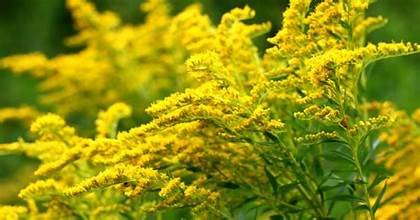
Goldenrod
How to Grow and Care for Goldenrod
David Beaulieu is a landscaping expert and plant photographer, with 20 years of experience.
Learn more about The Spruce's Editorial Process
Updated on 08/07/23
Reviewed by DEBRA LAGATTUTA
Goldenrod is a native North American perennial wildflower that is tall and slim with fluffy golden flower spikes in various shades of yellow. Once regarded as an invasive weed, goldenrod is increasingly valued by gardeners thanks to cultivars that offer better performance and more attractive flowers. Goldenrod grows best in any sunny location, survives well in average or even poor soil, and thrives in temperatures between 65 and 80 degrees Fahrenheit.
Common Name GoldenroBot
Banical Name Solidago spp.
Family Asteraceae
Plant Type Herbaceous, perennial
Mature Size 1.5–5 ft. tall, 1-3 ft. wide
Sun Exposure Full sun; partial sun
Soil Type Well-drained
Soil pH Acidic, neutral
Bloom Time Summer, fall
Flower Color Yellow
Hardiness Zones 2-8 (USDA)
Native Area North America
Goldenrod Care
Here are the main care requirements for growing goldenrod.
Plant goldenrod in the spring or fall, choosing a sunny location with average soil.
Stake the taller varieties so the plants don't flop and bend.
Water young goldenrod plants weekly to keep soil moist until established, then only supplement in drought.
Do not overfertilize; goldenrod does not need fertilizer at all.
The Spruce / Letícia Almeida
Light
Goldenrod craves full sun for optimal flowering. The plant will tolerate a bit of shade, though a shady location can reduce its blooms.
Soil
Goldenrod is not overly picky about soil but it must be well-drained with a pH in the acidic-to-neutral range. This plant can tolerate sandy, rocky, and clay soils. Very rich soil can cause the plant to become leggy and potentially flop over.
Water
Water new goldenrod plants weekly to maintain damp, but not soggy soil. Mature goldenrod plants are drought tolerant and rarely need supplemental watering except when rainfall is scarce.
Temperature and Humidity
The hardiness range varies a bit depending on the species, but most goldenrods thrive in USDA cold hardiness zones 2 to 8, taking heat and cold weather in stride. Goldenrod isn't fussy about humidity, either.
Fertilizer
Fertilizing goldenrod is typically not necessary because the plants do well in lean soil conditions. However, if the soil quality is poor or you wish to give your plants a boost to increase their height, add a layer of compost in the spring.
Too much fertilization often leads to floppy green growth and reduces flower production.
Types of Goldenrod
The many goldenrod species vary somewhat in size and appearance. Cultivars are known to be less aggressive spreaders than the species forms. Some popular species—all native to North America—include:
Solidago caesia (blue-stemmed goldenrod) has arching purplish stems. It is not an aggressive spreader and produces good cut flowers.
Solidago odora (sweet goldenrod) is a 2- to 4-foot plant with anise-scented leaves and yellow flowerheads. It does not spread aggressively and has a good tolerance for poor, dry soils.
Solidago rugosa, also known as rough goldenrod is a 3- to 5-foot plant with a fondness for moist conditions. A popular cultivar is 'Fireworks', with its arching golden-yellow flowerheads that resemble an exploding skyrocket.
Solidago speciosa, also known as showy goldenrod, grows 1 to 3 feet tall, with dense clusters of tiny yellow flowers.
Solidago sphecelata, also known as autumn goldenrod, is a 12- to 24-inch species with arching stems holding plumes of yellow flowers. Two notable cultivars are 'Golden Fleece', a short 15- to 18-inch plant with arching cylindrical flowers, and 'Wichita Mountains', a 30-inch plant with rich gold flowers.
Solidago bicolor (white goldenrod) is noteworthy simply because it does not display the typical yellow goldenrod blooms. Instead, it features white blooms.
Some hybrid cultivars to consider include:
'Baby Gold' (Solidago canadensis hybrid) is a 2- to 3-foot plant that produces its bright yellow flowers a little earlier from mid- to late summer.
'Little Lemon' (Solidago hybrida 'Dansolitlem') is an excellent compact variety (8 to 12 inches), with pale lemon flowers.1
'Peter Pan' (Solidago virgaurea) has very large spreading flower clusters on 2-foot plants.2
'Solar Cascade' (Solidago shortii,) is a 2- to 3-foot plant that produces plentiful golden flower heads.3
Pruning
Pruning stem tips early in the season can result in goldenrod plants becoming fuller and bushier and lead to more flowers later in the season. Deadheading spent flower heads can prolong the bloom season well into fall. Removing the flower heads before they go to seed can prevent rampant self-seeding. At the end of the season or in late winter, cut the plant stalks back to a few inches above ground level.
Propagating Goldenrod
Use this process to propagate goldenrod by division in the spring:
When new growth has just started, lift the entire plant out of the ground with a shovel. If it is too big to move in a single piece, do so in sections. Every section should have at least a couple of growth tips.
Shake off any excess soil, which helps to separate the rhizomes into smaller sections.
Replant each section at the same depth as the original plant and water it well. Keep watering the division until you see new growth.
You can also propagate goldenrod from cuttings:
In the early summer, use clean garden shears to cut 4-inch shoots from the base of the plant and dip the cut ends in rooting hormone.
Plant the cuttings about 1 inch deep in a 4- to 6-inch pot filled with potting mix and slowly water until the soil is evenly moist and water starts to drip out of the drainage holes.
Place the pot in a protected location out of direct sunlight and drying winds.
Keep the soil moist at all times.
When you see new growth, transplant the goldenrod into the garden.
How to Grow Goldenrod From Seed
Growing goldenrod from seed is easy; the only requirement for most Solidago species is a 60-day cold stratification period. This can be naturally achieved by sowing the seeds outdoors in a weed-free location in the late fall or early spring so the seeds are naturally exposed to prolonged cold, moist conditions.
Alternatively, you can artificially stratify the seeds by placing them in a sealed plastic bag outfitted with a damp paper towel, sand, or vermiculite. Store the bag in the refrigerator for 60 days at 40 degrees (or lower) Fahrenheit. After the stratification period, sow the seeds outdoors in early to mid-spring.
Sow the seeds shallow, no deeper than the width of the seed, and keep them evenly moist until seedlings emerge.
Potting and Repotting Goldenrod
Because goldenrod is a vigorous spreader, gardeners sometimes grow it in pots where it can be contained better than in garden beds. Use a container at least 12 inches in diameter with large drainage holes. Unglazed clay is ideal because it lets excess moisture evaporate.
Fill the pot with a quality potting mix, place the plant in the pot, and backfill with the potting mix. Water the plant slowly and thoroughly until the soil is evenly moist. Like all container plants, even established goldenrod needs to be watered regularly, unlike in a garden setting.
When roots grow out of the drainage holes, or the plant becomes root-bound, transplant it to a larger pot, or divide it and replant a section of it in a pot of the same size with fresh potting soil.
Overwintering
Goldenrod is a hardy plant up to USDA cold hardiness zone 2 and does not need protection unless grown in containers, in which case it is recommended to winterize the containers to insulate the roots against freezing temperatures.
In the garden, the stems can be cut down to a few inches above ground level after frost kills the foliage. Removing the stems, including seed heads, will reduce self-seeding in the garden.
Common Pests & Plant Diseases
Goldenrod can be attacked by beetles, aphids, and gall-forming insects, though the results are rarely fatal. The flower can also be affected by rust fungus, powdery mildew, and leaf spot. These fungal diseases are usually tolerated, though spraying with fungicide is an option. Most species prefer drier soils, and root rot is a possibility in dense, damp soils.
How to Get Goldenrod to Bloom
Bloom Months
Goldenrods are late-season bloomers producing their flowers from mid or late summer into fall, though the precise bloom period varies somewhat depending on species and cultivar.
What Does Goldenrod Look and Smell Like?
Goldenrod is a tall, slightly arching plant with a wider base than the tip. The long curvy stem and tip is filled with dense cylindrical clusters of yellow flower heads. The flowers have an anise-like scent, which is a mix of licorice and a sweet and spicy fragrance.
How to Encourage More Blooms
Other than giving the plant sun, there is not much else to do with goldenrod that will encourage more blooms. When these plants fail to bloom, it's usually because they don't receive enough sun. And like many native plants, giving excessive fertilizer to goldenrod can have a counterproductive effect by stimulating green growth but reducing flower production.
Deadheading Goldenrod
Deadheading spent flower clusters can extend the bloom period right up to killing frost.
Common Problems With Goldenrod
Goldenrod is the golden child of the garden and does not pose many problems. There are only a couple of things to watch for with this wildflower.
Aggressive Spreading
The most frequent issue arising with goldenrod is how to prevent it from spreading where you don't want it. Mature plants can spread via reseeding and underground rhizomes, potentially outcompeting other plants in the garden. To prevent this, grow goldenrod in containers or a garden bed with barriers to contain the underground spread.
Another way to control the spread is to divide your goldenrod often, at least every two to three years, so it doesn't have the chance to expand. Also, deadhead spent flower heads promptly to stop them from spreading their seeds if you don't want new plants to pop up. Or better yet, cut the flowers to use in floral arrangements.
Leggy Growth
Goldenrod can become leggy and floppy for two reasons: too much fertilizer and overly rich soil. When goldenrod becomes leggy, it tends to flop over.
FAQ
How can this plant be used in the landscape? Goldenrod is most often used in naturalized settings, such as meadows, prairie gardens, seaside, and other wildflower-rich areas. It is widely known as a plant that attracts Monarch and other butterflies, making it the perfect addition to any butterfly garden. It also attracts other pollinator insects, including bees. Deer rarely feed on goldenrod.
How long does a goldenrod plant live? Goldenrod that colonizes in a naturalized area can live indefinitely as the rhizomatous roots gradually spread and the plant self-seeds itself. Left undisturbed, a clump of goldenrod might live for decades. In garden settings, it's more common to divide the clumps every two or three years to keep the plant from spreading too vigorously.
What is the difference between ragweed and goldenrod? Goldenrod is often confused with ragweed because it is also a late-season bloomer that grows along roadsides. The plants are roughly the same size and are often found growing side-by-side, but while some ragweeds have yellowish flowers, they lack the bright hues of goldenrod. Ragweeds are virtually never planted as garden plants, as they are rather unattractive plants. Ragweed pollen has high allergy potential, while goldenrod, despite its reputation, does not.
Why do farmers plant goldenrod? Goldenrod attracts migrating butterflies and bees which are needed for crop pollination. Having lots of goldenrod around is crucial for fruit production.

